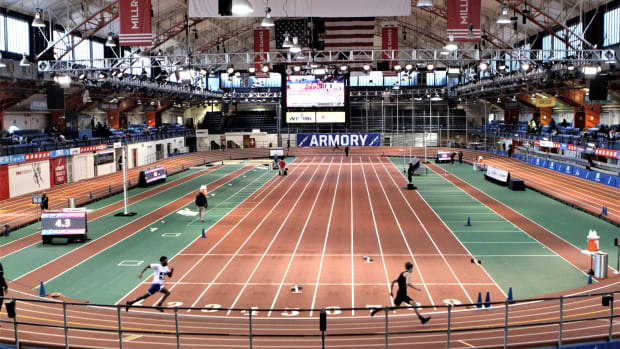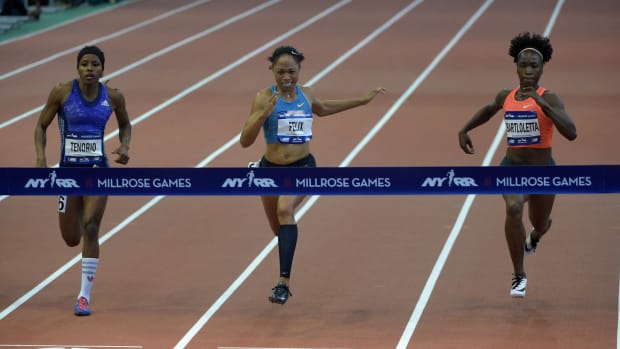Mrs. A has seen it all. Born in 1909 on Fort Washington Avenue between 168th and 169th Streets in Washington Heights. Served the military, housing some 500 Army volunteers (Fourth Brigade, 22nd Regiment). Housed tanks. Opened home to the city’s fastest runners, longest jumpers and swiftest hurdlers, starting in ’14. Expanded scope, from local to regional to the entire East Coast; throughout America; across the wider world. Stayed local. Never moved. Became an institution that stamped memories and won acclaim and challenged a running city built with Swoosh money in Oregon for track and field supremacy. Became known for copious splinters and marvelous sprinters. Gave floor burns. Fixed broken windows. Repaired leaking pipes. Exterminated unwanted insects. Helped shelter unhoused people. Confronted urban decay. Suffered from it, too. Endured wars, protests, neighborhood violence, drug epidemics, blackouts, recessions. Made history. Set records. Won deserved acclaim. Nearly went bankrupt. More than once. Decided, no more sports. Was disregarded. Criticized. Understaffed and overstuffed. Grew old. Wore down. Nearly died a thousand different deaths. Resuscitated in ’93, steered back to life by a mayor who cared about its impact on local youth and a good doctor who won the New York City Marathon in ’74. Vaccinated hundreds of thousands during the pandemic. Home to the occasional board exam.
Next January, Mrs. A will turn 115. If that sounds impossible, it’s because Mrs. A is actually a building, The Armory, a space that has been revered (mostly) and reviled (for its tenure as a men’s shelter). But Mrs. A, while technically a building, is that and more than that, far more than that. It’s a living, breathing, changing, inspiring, record-setting … thing. It’s walls come to life with history, making Mrs. A local institution for its neighborhood and an international destination for the track types.
Mrs. A made the National Register of Historic Places. She helped New Yorkers emerge from COVID-19 by hosting a record number of events in 2021 and ’22. This past January, she partnered with Nike for a transformed/transforming indoor track and field center. In October she will begin yet another season. And, while her track is no longer splintered, outdated or plain dangerous, it remains the main source of Mrs. A’s fame. She’s often dubbed The Fastest Track in the World.
On Monday morning last week, one of Mrs. A’s most pivotal employees stands on that track and scans the walls nearby. Her mind pivots backward and forward, between what was and what will be. She’s dressed in all white; even pointy white heels. She stands at the starting line, with nary a splinter (or sprinter) in sight. An oversized American flag hangs nearby, marking one relic that, when juxtaposed with all the new flourishes, speaks to the modernization of Mrs. A.

Nancy Haggerty/The Journal News/USA TODAY Network
Rita Finkel is describing the ongoing transformation of a once-proud building returning to its most functional, most impactful state. It started before she did there, before her arrival in 2006, after operating America’s oldest continuously running fencing club for six years (and raising three elite fencers). The track still looked like a NASCAR loop back then. Before she fought for the current blue iteration. David Dinkins Jr., the first Black mayor in New York history, assisted with fundraising and bolstering available resources. Several others petitioned across the five boroughs, hunting for donations.
Late-morning sunlight sneaks through massive glass windows near the track, bathing half the space in light, giving off cathedral vibes. But amid all the old school, modern touches stand out. Like the full television studio. The ubiquitous advertisements. The oldest closet fashioned into a café. The other old closet turned into a meeting space with spiffy glass windows and a view of the track. The spaces for cocktail parties and tailgates and schmoozing between track bigwigs and donors. (Up next: sushi-and-sumo night, where diners can choose between sushi and—gulp!—actual wrestling.)
Finkel points at the finish line, which doubles as one of the more historic stripes in sports. In 2022 alone, 26 national records and three new world marks were set, right there. Right where Dr. Anthony Fauci stood to be honored alongside iconic long jumper Bob Beamon in February. Both watched another Millrose Games (Mrs. A’s signature event) unfold for the 115th time. At one point, Finkel saw Fauci lean toward Beamon. “You’re my hero,” he said.
“I was standing right there,” she says of one favorite moment, when Drew Hunter broke Alan Webb’s indoor mile record before a raucous crowd, the atmosphere intensified by the stands’ proximity to the track (and sold-out crowds) (and New Yorkers). Poetry, she says.
That’s Mrs. A, too, the rare space in sports that grows and falters and imbeds and nearly dies, only to transform into its own sort of athletic cathedral. Mrs. A sits on 1.9 acres of land in a city with no abundance of physical space. Everything is condensed. That famous track is six lanes wide. Inside the loop: two runways, a pair of sand pits, another pit for pole vaulters and a cage for the throwing competitions mean chaos, the glorious kind distinct to track and field, for larger meets.
In important ways, Finkel says the soul of The Armory remains. She said this while playing tour guide last week, which might be her favorite part of the gig. See, Finkel is copresident of The Armory and director of Armory College Prep, both part of the nonprofit that operates Mrs. A, who is far more than the track and 5,000 close-close-and-closer seats. This means that Finkel must continuously remind the rest of the sports world that The Armory has always focused on local youth, particularly those from disadvantaged areas, long before becoming a mecca for international competitions. Mrs. A offers track but also classes for computers, college prep, computer science and investing, while providing academic counseling and guidance for filling out college applications. This means that Finkel must also continuously hunt for donations.
The name Finkel mentions most often is Norbert Sander Jr., a doctor who spearheaded (alongside his friend, longtime chairman of the board Michael Frankfurt) the extreme makeover that began in the early 1990s. At that point, The Armory was already long established but had fallen in disrepair. Mrs. A had hosted meets for nearby colleges (Manhattan, Fordham, NYU), high school athletes (Public School Athletic League, AAU competitions) and university championships (IC4A). Mrs. A had not yet witnessed Webb’s spectacular sub-four-minute mile (2001), the first recorded by an American high schooler; nor all those broken records; nor all the future Olympians honing their medalist skill sets. Before she could, she needed more attention.
Sander made use of the property’s wasted space. Up went towering steel beams and those glass windows fashioned for sunlight. Out went the wooden planks that runners raced on. Down went a synthetic surface, which allowed participants to wear spikes. Mrs. A began hosting more than 100 events a year, just for track. Elite athletes followed. Some came from as far as France. Sander, Finkel and others raised more than $25 million, when combining public and private donations. In the three decades since The Armory’s reopening, Sander never stopped running toward a better future for Mrs. A, which makes sense, considering he’s still the only native New Yorker to win the city’s marathon (1974).
Finkel spins through all the improved spaces. There’s the history gallery, which can fit 200 guests for receptions and features moveable memorabilia kiosks. There’s the Hall of Fame atrium, home to the sport’s national hall and other honorees, with its older touches (original master staircase, from 1909; a Guastavino ceiling) and modern upgrades (interactive displays). And the Millrose Boardroom (OG fireplace and chandeliers; new audio-visual equipment). And the enhanced theater (ceiling mounted HD projector; choose: natural light or blackout blinds). And a marathon hall. And a hospitality saloon.
As she tours and talks, one notion rises above the others. Yes, some of the best athletes in the world have competed inside The Armory. They have set world records, prepped for Olympic glory and thrilled rowdy crowds who support and trash-talk in equal measure. They have become stars. But here, inside these hallowed walls, they aren’t the stars. Mrs. A is. They weren’t before. Mrs. A was.
This, all this, despite the near death, the nadir the period when Mrs. A became a men’s shelter rife with drugs and crime. She is no longer barely surviving. No longer just surviving. Finkel cannot help but lapse into her schedule, mentioning this meeting and that cocktail party and this event and that fundraiser, all with donors who walk inside, missing only blinking neon dollar signs above their heads.
“There’s really so much more to do,” Finkel says. Of everything, she means. More donors. More resources. More children coming to the largest after-school activities center in New York City. More prospects turned champions or scholars. More scholarships. More classrooms. More projects. More records on the splinter-free track.

Kirby Lee/USA TODAY Sports
The sport itself seems to be on the verge of—or already having—a moment. The U.S. team won 26 medals in Tokyo and is stocked with young stars (Sydney McLaughlin-Levrone, Athing Mu, Gabby Thomas, Erriyon Knighton, Noah Lyles, Michael Norman, Grant Holloway, Rai Benjamin). At the 2022 world championships in track and field’s other mecca (Eugene, Ore.), the Americans turned in their best-ever worlds performance, snagging 33 medals and winning the team trophy with a staggering 328 points. USATF participants managed to win medals in 22 separate events. They won 13 golds. American men swept both medal podiums in the 100- and 200-meter dashes, another WC first. All spoke to a skilled and deep talent pool that appears to be growing in size and gaining in momentum. Which speaks, in part, to the modernization of Mrs. A and the impact that resulted, that will result.
The last Millrose competition was broadcast on NBC, available in 110 countries across the world. New track fans started to pop by, wanting to hear what Mrs. A’s walls had to say. More seniors started coming by for workouts. More students filled the classrooms. Whether this cycle can push track back into the mainstream sports’ consciousness in any year but a star-powered Olympic one seems difficult, at best; impossible, at worst. But, as Mrs. A proves at least anecdotally, stronger facilities matched with stronger international-stage performances twin nicely in a potentially virtuous cycle. Either way, the symmetry doesn’t hurt.
Finkel has plans. So, so, so many plans. There’s a blind marathon runner who trains at The Armory and is working with Google to develop new technology for others like him. Doctors, nurses, EMTs and dentists stop by in white lab coats to meet with students. Mrs. A now hosts Fastest Kid in the World competitions. It fields competitive youth robotics teams.
Finkel talks and tours, talks and tours. She tells entertaining stories about history—like when The Armory purchased the Millrose Games for $1, continued to stage the event at Madison Square Garden, then brought it to a loving track home, for a more intimate setting, in a most critical time. But as she tells them, her eyes seem to wander, even dance at certain times, when locked onto certain spaces. Why eventually becomes obvious. She’s looking for other spaces to renovate, update, bolster, add, enhance. “Don’t think I’m not eyeballing,” she says.
Which, for Mrs. A, can only mean that in this same place, in this upgraded space, walls that have witnessed all manner of suffering, all manner of joy and all manner of humanity, from troops to unhoused people to track stars, seen it all might never be accurate. “This really is a living, breathing organism in this city,” Finkel says, while the walls that speak but only the language of history—ostensibly? perhaps?—whisper something like amen.







